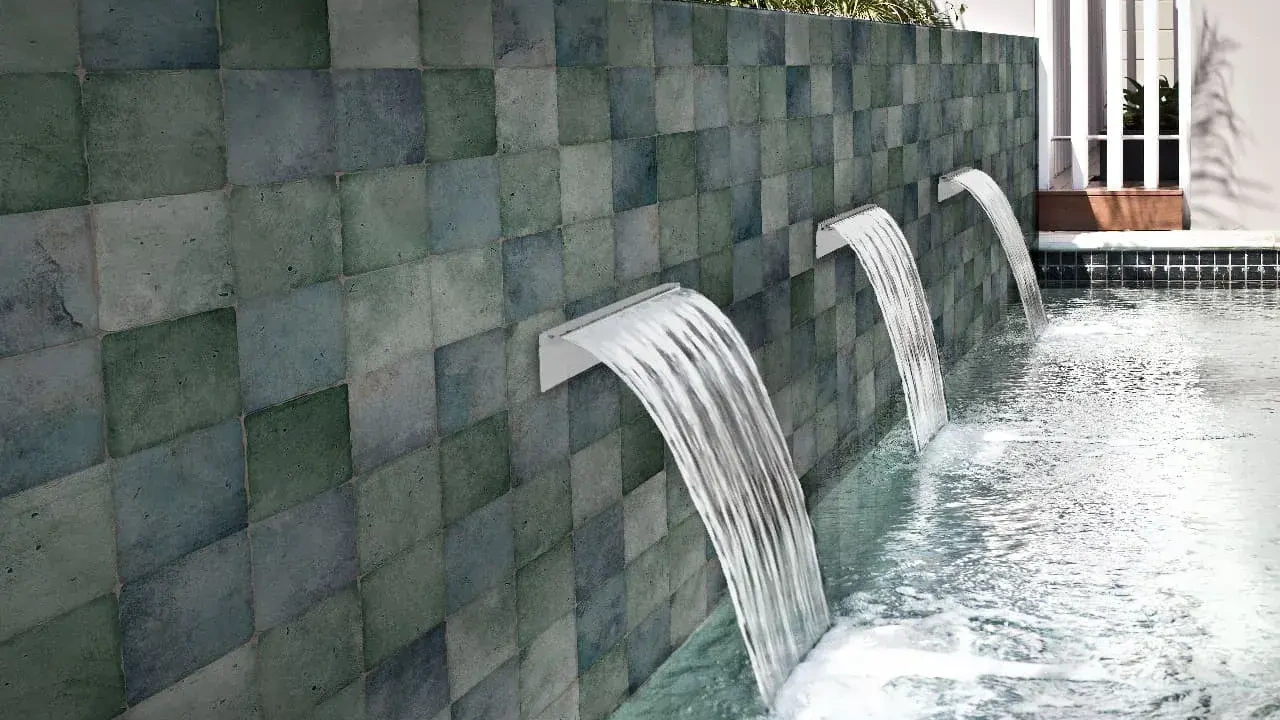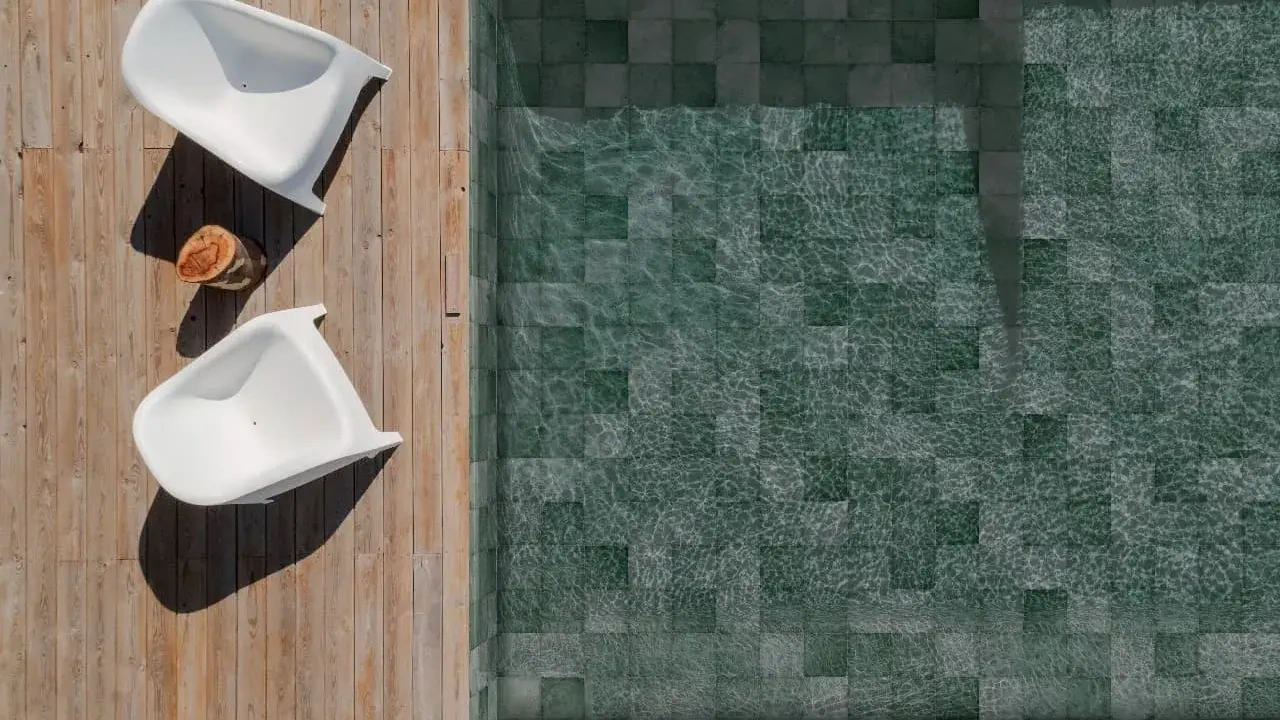When it comes to designing a pool, choosing the right tiles is essential for achieving an attractive and functional finish. Pool tiles not only play a crucial role in aesthetics but also affect the durability and maintenance of your pool. From water-resistant and slip-resistant options to designs that mimic the natural beauty of stones and wood, the market offers a wide range of tiles that can transform your pool into a luxurious and comfortable oasis.
In this post, we will explore the best pool tile options, highlighting their features, benefits, and how they can elevate the style and functionality of your aquatic space. Looking for tiles for a modern pool? Discover how to choose the perfect tiles that combine beauty and durability, and take the new step towards the pool of your dreams.
Dive with us into the world of pool tiles and find the option that best suits your style!
Advantages of using pool tiles
Durability and strenght
Porcelain tiles are extremely durable and resistant to adverse water and weather conditions. They can withstand heavy use and exposure to chemicals without losing their integrity or appearance, resulting in a long lifespan, wich mean fewer expenses on repairs and replacements over time.
Customized aesthetics
Tiles offer a wide variety of designs, colors, and textures, allowing you to customize the pool’s appearance according to your desired style.
Slip resistance
Many pool tiles are designed with slip-resistant finishes that enhance safety, especially in wet and slippery areas, such as pool stairs. This is crucial for preventing accidents and ensuring safety.
Easy maintenance
Tiles are easy to clean and maintain. Their smooth, non-porous surface resists the gowth of algae and mold, and their cleaning typically requeries less effort compared to other materials.
Chemical resistance
Tiles, parcitularly porcelain ones, are resistant to the chemicals used in pool water treatment, such as chlorine, wich helps maintain their appearance and longevity.
Versatility in applications
Tiles are not only used for the interior lining fot he pool but also in surroundings areas, edges, and steps. This allows for harmonious integration between the pool area and the surrounding landscape.
Added value
Installing high-quality tiles can increase the aesthetic and commercial value of a property. Well-designed pools with elegant and functional tiles can significantly enhance the overall appearance of the property.
Easy repair
In case of damage, tiles are relatively easy to replace individually without the need to renovate the entire pool lining.

Tips for customizing your pool design with tiles
Choose a theme or style
Before selecting tiles, define the theme or style you want for your pool. It could be a Mediterranean look with blue and white tones, a tropical style with vibrant green tiles, or a minimalist design with neutral colors. Having a clear concept will help you choose the tiles that best suit your taste and style.
Mix colours and textures
Use different colors and textures of tiles to create a dynamic and unique design. For exaple, you can use glossy tiles on the pool for a sparkling water effect and matte or slip-resistant tiles on the edges for added safety. Mixing different finishes and sizes can also add depth and character to the design.
Higlight key areas
Use decorative or contrasting colored tiles to higlight specific areas, such as steps, seating, or integrated spas. This not only adds visual appeal but also enhances safety by making high-traffic areas more visible.
Consider mosaic tile designs
Mosaic tiles can add an artistic touch to your pool. You can create geometric patterns, marine motifs, or even customize the space with a unique design that reflects your personality or interests. Mosaics are perfect for floors, walls, or details on the steps.
Use gradual tones for visual depth
To add depth and create a striking visual effect, use a gradient color palette that transitions from dark to light tones from the bottom of the pool to the surface. This can make the pool appear deeper and more inviting, creating a smooth and appealing visual effect.
Opt for natural tiles for an organic style
If you prefer a more natural style, choose tiles that mimic materials such as stone, marble, or wood. These materials can blend with the surroundings, creating a sense of harmony with the landscape around the pool, wich is ideal for gardens or green areas.
Consider the surroundings and natural light
Think about how natural light interacts with the space. Darker tiles can absorb more heat, while lighter ones reflect light, keeping the surface cooler. Depending on your pool’s location and climate, select colors and finishes that complement the surroundings.
Add details to the edges and overflow areas
Don’t just use tiles for the interior of the pool; the pool adeges are a great opportunity to add decorative details. Be sure to use slip-resistant pool tiles and choose colors that contrast with the water to create an attractive visual separation.
Customizing your pool design with tiles is a wonderful way to transform your aquatic space into a reflection of your style and personality. From bold patterns to soft color combinations and unique textures, tiles offer endeless possibilities to create a unique and appealing pool that becomes the focal point of your home. Let your creativity flow and enjoy a pool designed just for you!
Key considerations for choosing pool tiles
There are many types of pool tiles, so selecting the right ones is not only a matter of aesthetics but also of functionality and durability. Several factors must be considered to ensure that the tiles not only complement the overall design but are also safe and long-lasting. Here are some key aspects to consider when choosing tiles for your pool:
Type of material
- Porcelain stoneware: This is the most recommendend material for pools due to its resistance to moisture, temperature changes, and chemicals. It also offers a wide variety of finishes, colors, and textures.
- Glass: Glass tiles are highly decorative and resistant to fading, but they can be more slippery.
They are ideal for decorative details or areas with low traffic.
Type of texture and slip-resistant properties
- Slip-resistant surface: Ensure that the tiles have an appropriate slip-resistance rating, especially if they will be used in high-traffic areas, on pool edges, or on the steps. Tiles with a rough surface or textured finishes can help reduce the risk of falls.
- Comfort to the touch: The texture should be comfortable for bare feet without being too abrasive. A good balance between safety and comfort is key to an optimal user experience.
Colors and Designs
- Light colors vs. dark colors: Light colors, such as blues and whites, can make the pool appear larger and brighter, while dark colors like blacks or deep blues can create a sense of depth and sophistication.
- Style and customization: Consider the surrounding decor. Mosaic tiles allow for the creation of custom patterns and designs, while large pool tiles offer a more uniform and modern look.
Tile size
- Large pool tiles: These can be quicker to install but may require more cuts if the pool has complex shapes.
- Small pool tiles: Mosaic or small square tiles are better suited for the curves and irregular shapes of a pool, allowing for a more detailed and uniform finish.
Durability and strenght or pocelain tiles
Porcelain tiles are one of the most popular and versatile options for both interior and exterior design due to their remarkable durability and strenght. Made from a blend of fine clay, quartz, feldspar, and other natural materials subjected to high temperatures, porcelain tiles offer unique characteristics that make them ideal for a wide range or applications, including use in pools and wet areas. Here are the key aspects that contibute to their durability and resistance:
High density and low porosity
With water absorption of less thatn 0,5% they are extremely resistant to moisture and frost. This feature makes them an excellent choice for outdoor appliations and areas with constant water contact, such as pools.
Abrasion and wear resistance
Thermal stability
Porcelain tiles are highly stable against sudden temperature changes, making them suitable for both warm and cold climates. They do not deform, crack, or discolor with prolonged exposure to sunlight, snow, or ice.
UV Resistance
They are resistant to ultraviolet rays, so they will not fade or lose color over time, making them an escellent choice for pools where intense sunlight could affect other materials.
Minimal maintenance
They are easy to clean, do not require special sealers, and offer long-term durability, maintaining their appearance and functionality for decades, providing a very favorable cost-benefit ratio.
Current trends in pool tiles
Current trends in pool tiles focus on combining functionality with attractive and contemporary design. The aim is to create unique spaces that reflect the owner’s personality, with an emphasis on sustainable and durable materials, as well as styles that enhance the aesthetics and feel of the pool water. Here are some of the most notable trends:
Natural colors and earthy tones
Pools with moss green, brown, gray and beige tiles are trending as they allow the pool to harmoniously blend with the natural surroundings. These colors provide a sens of calm and connection to nature. Deep blues and dark greens, reminiscent of lake or ocean water, are also used to create a more relaxing and refreshing atmosphere.
Textured and slip-resistant tiles
It is important to consider using slip-resistant pool tiles, as safety is a priority. There is a trend towards using textured or matte-finished tiles that offer slip-resistant properties without sacrificing style. Surfaces that mimic materials like stone, wood, or even concrete are becoming increasingly popular. These material add a rustic or industrial look to the pool environment.
Mediterranean style
The Mediterranena style, featuring tiles in blue and white tones and designs inspired by traditional ceramics from countries like Spain, Greece, and Morocco, is very popular. This style incorporates detailed pattens such as arabesques, geometric shapes, or floral motifs that add a decorative and unique touch to the pool.
Matte finishes and soft tones
Matte finishes are trending, especially in fost colors like sky blue, jade green, and warm grays, wich create a sense of calm and sophistication. These finishes are good choice because they reduce sun glare and offer a more natural and elegant appearance.
Use of hexagonal and irregular shapes
Hexagonal tiles and other unusual geometric shapes, such as fish scales, are being used to add an unexpected and modern decorative element to pools. These designs offer a unique alternative to traditional square or rectangular tiles, allowing for more creativity in the layout.
Inspiration from wellness and spa spaces
Pools inspired by spas and wellness centers are increasingly popular. This involves using relaxing colors, natural effects, and smooth textures, as well as incorporating features like waterfalls or fountains to complement the sense of tranquility and relaxation.

As we’ve discusse throughout this post, choosing tiles for pools involves considering various factors such as safety, durability, maintenance, and of course, the desire style. Each type of material offers unique advantages that cater to different customer needs and preferences. Current trends focus on blending functionality with aesthetics, incorporating natural colors, textured finishese, and innvoative designs that trahsform pools into unique and personalized spaces. Ultimately, the gest choice will balance all these aspects, ensuring not only beauty but also comfort and safety in the aquatic environment.
And you, do you have a clear idea of wich tiles you would choose for your pool?

